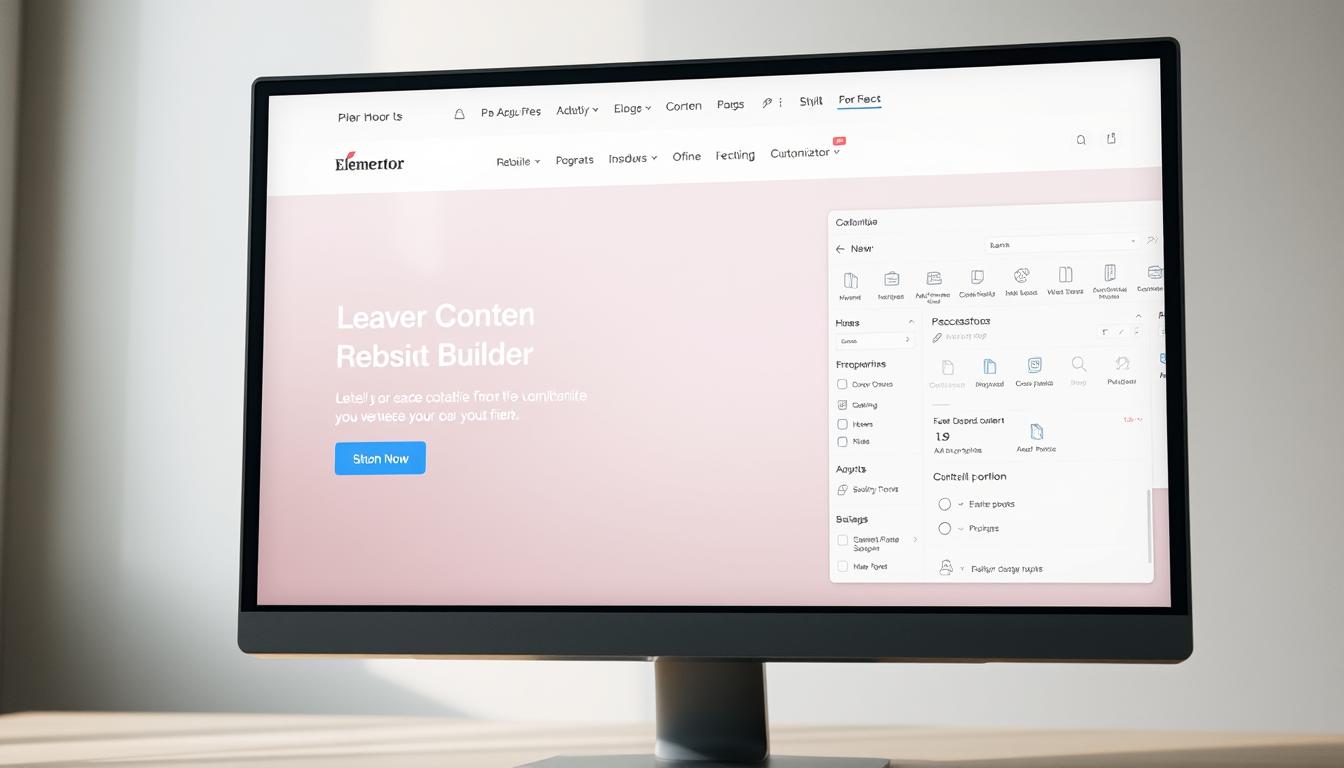Ever wondered why some landing pages turn visitors into customers, while others don’t? This article offers a detailed Elementor landing page tutorial. It answers your questions and shows you how to create engaging landing pages on your WordPress site. Elementor’s easy-to-use interface makes it simple, even for those without tech skills.
Get ready for a step-by-step guide on using Elementor. You’ll learn about powerful design elements and strategies. These will make your landing pages stand out and bring in results.
Introduction to Landing Pages
A landing page is a special web page made for specific marketing goals. It’s designed to get leads or email sign-ups. It has no navigation links to keep users focused on one action.
What is a Landing Page?
Knowing what a landing page is means understanding its role in digital marketing. It’s a focused platform for getting conversions. It aims to turn visitors into leads or customers with information that meets their needs.
Importance of Landing Pages
Landing pages are very important in digital marketing. They help improve conversion rates. Studies show they can get much higher conversion rates than regular web pages. This makes them key to any marketing plan.
Key Elements of Effective Landing Pages
Creating effective landing pages requires attention to several key elements. A clear headline grabs attention right away. Visual hierarchy guides users to CTAs. Trust indicators like testimonials build credibility.
Using tools like Elementor can help add animations and sticky headers. This boosts user engagement.
Getting Started with Elementor
Understanding Elementor is key to making great landing pages. It’s a top page builder for WordPress that lets you design pages easily, without coding. Its drag-and-drop feature makes creating custom layouts simple for anyone.
What is Elementor?
Elementor is a powerful tool in the digital world. It’s a versatile page builder that helps users make beautiful websites. It’s flexible and efficient, with many features for different design tasks.
Why Choose Elementor for Landing Pages?
Elementor is great for landing pages for many reasons. It has a huge library of customizable templates and widgets. You can adjust these to fit your needs, improving user engagement. Plus, it’s optimized for all devices, making your pages look good everywhere.
Installing Elementor on Your WordPress Site
Installing Elementor is easy. Go to your WordPress dashboard, then the Plugins section. Click Add New and search for “Elementor”. After installing, activate it and start setting up. Following a setup guide will help you use all its features, making your landing pages more effective.
Setting Up Your Elementor Workspace
Learning how to set up your workspace is key when using Elementor. It doesn’t matter if you’re new or have experience. Knowing the Elementor interface well will make designing websites better. Here’s a detailed guide to help you get started with Elementor.
Accessing Elementor
To begin, go to any page on your WordPress site. Click the “Edit with Elementor” button. This opens the Elementor editor. It’s where you can make amazing landing pages with many widgets.
Understanding the Interface
The Elementor interface has three main parts. The Widget Panel holds design elements like buttons and images. The Settings Dashboard lets you adjust layout and styling. The Preview Canvas shows your design live, so you can see changes right away.
Customizing Your Settings
Customizing Elementor settings is important for matching your pages with your brand. You can change global colors, fonts, and more. This makes all your pages look consistent, improving your website’s look.
| Interface Component | Functionality |
|---|---|
| Widget Panel | Contains all design elements like text, images, and videos for page building. |
| Settings Dashboard | Offers layout and styling options to customize user experience. |
| Preview Canvas | Displays real-time views, allowing for immediate adjustments and feedback. |
Choosing Your Landing Page Template
Finding the right template is key to a great landing page. Elementor offers many templates for different industries and needs. This variety helps users find the perfect template to connect with their audience.
Exploring Pre-built Templates
Elementor has over 400 templates, sorted by industry and purpose. Users can browse through categories to find a template that fits their goals. Filtering options help find templates with high conversion rates, making the selection easier.
How to Import a Template
Importing Elementor templates is easy. Just pick a template from the library and click “Edit with Elementor.” This brings the template into the Elementor editor, ready for customization. This quick process lets users start their projects fast, saving time.
Customizing Your Selected Template
After importing a template, it’s time to customize it. Users can change global colors, fonts, and content to match their brand. They can also swap images and update text. These changes make the template unique and effective.
Designing Your Landing Page
Creating a great landing page needs careful attention to detail. Elementor makes designing landing pages easy with its user-friendly tools. These tools help improve your page’s layout.
Adding Sections and Columns
Adding sections in Elementor is key for organizing your content. You can use flexbox containers or CSS grids to create structure. These tools help make your layout look good and improve user interaction.
Inserting Widgets
Widgets are the core of your design in Elementor. They let you add things like images, buttons, and text boxes easily. Customizing these widgets can make your page more engaging and fun for visitors.
Utilizing Drag-and-Drop Functionality
The drag-and-drop feature in Elementor is a big help. It lets you move page elements around without coding. This makes designing your landing page easy and fun, focusing on creativity and look.
Customizing Style and Layout
Creating a visually appealing landing page is all about style and layout. In Elementor, you can customize backgrounds, adjust typography, and personalize colors and borders. This ensures your landing page looks good and works well.
Setting Backgrounds and Images
A strong visual foundation starts with effective background settings in Elementor. You can choose from solid colors, gradients, or images. To customize backgrounds, go to the style settings and pick what fits your branding and design.
Adjusting Typography
The typography in Elementor greatly affects readability and looks. Picking the right fonts and sizes is key for keeping visitors engaged. By customizing fonts, you can show off your brand’s personality while making sure headlines grab attention and body text is easy to read.
Personalizing Colors and Borders
Colors and borders set the tone of a landing page. By customizing colors and borders in Elementor, you can create a consistent look that connects with your audience. Using global settings helps keep everything uniform. This makes your brand stand out and navigation easier for users.

For more tips and tutorials on style and layout, check out Elementor’s academy.
Crafting Engaging Content
Creating impactful landing pages depends a lot on the quality of your content. Writing catchy headlines, organizing your copy well, and using strong calls-to-action in Elementor are key. These elements help keep users engaged and boost your conversion rates.
Writing Compelling Headlines
Creating headlines in Elementor that grab attention is critical. A headline should clearly show the main benefit of the page and meet user needs. It should be clear, impactful, and match the page’s overall message.
Structuring Your Copy for Clarity
To make your content easy to read and use, organize it well in Elementor. Use short paragraphs, bullet points, and subheadings. This helps users follow along easily, understand the main message, and take action.
Adding Calls-to-Action
Good CTA strategies are essential for getting more conversions. When using calls-to-action in Elementor, use clear, direct language. Place them in key spots on the page. This guides users on what to do next, improving their experience and encouraging them to interact.
Integrating Multimedia Elements
Multimedia elements make landing pages more effective. Using images and videos in Elementor keeps visitors interested. High-quality visual content, like product showcases or informative videos, helps explain complex ideas. This can lead to higher conversion rates.
Incorporating Images and Videos
Adding graphics to landing pages makes them lively and engaging. High-resolution images that match your services make the page welcoming. Videos give visitors a deeper look into what you offer. With Elementor, adding these elements is easy, making your information stand out.
Adding Icons and Graphics
Icons in Elementor help guide users and highlight important points. They act as visual signals, pointing to calls-to-action and key messages. This small detail can greatly improve the user experience, making key information clear.
Using Animations for Engagement
Animations in Elementor grab attention and keep it. Well-placed animations make a landing page more engaging. They create a lively flow, keeping visitors interested and moving toward your goals.
For more tips on multimedia in landing pages, check out this resource.
Optimizing for Mobile Devices
In today’s digital world, making sure your site works well on mobile is key. With Elementor, you can make your landing pages fit smaller screens. This boosts user happiness and keeps them coming back.
Responsive Design Principles
Responsive design makes your page change size smoothly for different screens. It makes sure everything looks right, from images to buttons. This way, your site works great on phones and tablets.
Adjusting Settings for Mobile View
Elementor’s mobile settings make tweaking your site for phones easy. You can change font sizes and layouts for smaller screens. These tweaks make your site look good and work well on mobile.
Testing Mobile Responsiveness
It’s important to test how your site looks on different devices. Elementor lets you see how your site looks on various devices. This helps you fix any problems before your site goes live.

Good mobile testing helps you see how people use your site. Looking at your site’s analytics can help you make it better. This ensures your site is both pretty and useful.
For more tips on making mobile shopping better, check out this resource on launching a successful e-commerce.
SEO Best Practices for Landing Pages
The success of a landing page depends a lot on its SEO. Businesses must focus on search engine optimization to rank higher in search results. This attracts more customers. A well-optimized landing page brings in quality traffic and boosts visibility on search engines.
Importance of SEO for Landing Pages
Ignoring SEO can mean missing out on chances. A well-optimized landing page helps people find your products and services online. Good SEO for landing pages means your content is where people are looking, which boosts your conversion rates.
Key SEO Elements to Include
Creating a landing page requires several key SEO elements. Relevant meta tags are essential for search engines to understand your page’s content. Also, use optimized image alt tags and place keywords wisely in your text. Each element should look good and meet search engine needs for the best results.
Using SEO Plugins with Elementor
If you use Elementor, adding SEO strategies can make optimization easier. SEO plugins like Yoast SEO or Rank Math help manage meta tags and keywords. These tools help you track and improve your SEO performance while optimizing with plugins.
Knowing and using these SEO best practices helps landing pages attract and engage visitors. For more tips on improving your landing page’s SEO, check out this link.
Testing and Optimizing Your Landing Page
Improving your landing page’s performance is a continuous process. It involves testing and tweaking. Companies should use A/B testing to make their pages better for users and increase sales. This method compares different versions of a page to see which one works best.
A/B Testing Basics
A/B testing is key to making your landing pages better. It lets teams try out different things like headlines and CTAs. This way, they can find out what works best for their audience.
Analyzing Performance Metrics
Important metrics for landing pages include conversion rates and bounce rates. These numbers help you understand how well your page is doing. Tools like Google Analytics give you the data you need to make changes.
Making Data-Driven Adjustments
After you’ve looked at your metrics, it’s time to make changes. Use what you’ve learned to improve your page. This might mean changing the content or the layout. Always keep working to make your page better.
To learn more about how to improve your landing pages, check out this article on optimizing landing pages with. By constantly testing and improving, you can see better results over time.
Launching Your Landing Page
Launching your landing page needs careful planning and action. Start with a final checklist to make sure everything works right and meets your goals. After launching, it’s important to bring in traffic and watch how your page does to keep improving.
Final Review Checklist
Before you go live, it’s key to check your landing page. Make sure:
- There are no broken links to keep users happy.
- The design looks good and is consistent.
- Forms work smoothly.
- The content is right and easy to understand.
Promoting Your Landing Page
To get people to your landing page, use different ways to promote it. Good methods include:
- Using social media to get people excited.
- Reaching out to customers through email.
- Running ads to reach more people.
Using SEO tips can also help more people find your page, bringing in more visitors.
Tracking Performance Post-Launch
It’s important to keep an eye on how your landing page is doing. Watch things like:
- How users interact with your page.
- How many people are converting.
- Where your visitors are coming from.
By analyzing your data, you can make better choices for your next campaign. This helps keep your efforts successful over time.
Conclusion: Recap and Next Steps
This guide covered the basics of creating a great landing page with Elementor. It showed how to use Elementor’s easy-to-use tools to make unique designs. These designs aim to get more people to take action.
For those wanting to learn more, try out Elementor’s many features and templates. This can lead to new ideas in landing page design. Using Elementor can make your projects stand out and improve how users feel.
Looking to get better at Elementor? There are many resources out there. The official Elementor Academy, forums, and video tutorials can help. They offer tips on using Elementor’s advanced features. Using these resources can make your landing pages even more impressive.
FAQ
What is Elementor?
Elementor is a top page builder plugin for WordPress. It has a simple drag-and-drop interface. This lets users make amazing landing pages without coding.
Why should I use Elementor for creating landing pages?
Elementor is great for landing pages. It has lots of customizable templates, widgets, and tools. These help make pages more engaging and boost conversion rates.
How can I install Elementor on my WordPress site?
To install Elementor, go to Plugins > Add New in your WordPress dashboard. Search for “Elementor,” click install, and then activate. Make sure your hosting meets Elementor’s needs for best performance.
What are the key elements of an effective landing page?
Important elements include a clear headline and a visual hierarchy. This guides users to the call to action (CTA). Trust indicators like testimonials and strategically placed CTA buttons are also key.
Can I customize landing page templates in Elementor?
Yes, you can customize any template in Elementor. Change global colors and fonts, swap images, and update content. This helps match your branding and messaging.
What types of widgets can I use in Elementor?
Elementor has many widgets, like text boxes, images, buttons, and forms. You can drag-and-drop these onto your page. This makes your page more interactive and visually appealing.
How do I ensure my landing page is mobile-responsive?
Elementor makes it easy to make your page mobile-friendly. You can adjust settings for mobile views, like font sizes and layout. The responsive editing mode lets you see how your page looks on different devices.
Why is SEO important for landing pages?
SEO is key for landing pages to rank well in search results. It attracts the right audience and drives quality traffic. Optimized pages are more visible and have better conversion rates.
What is A/B testing and how can I use it with Elementor?
A/B testing compares different landing page versions to see which works best. Elementor lets you test different headlines, layouts, and CTAs. This helps improve your conversion rates.
What should I include in a final review checklist before launching my landing page?
Before launching, test for broken links and review design elements. Make sure forms work as they should. This ensures a smooth launch.
I’m into tech, trends, and all things digital. At CrazeNest, I share what’s new, what’s next, and why it matters — always with a curious mind and a creative twist.





